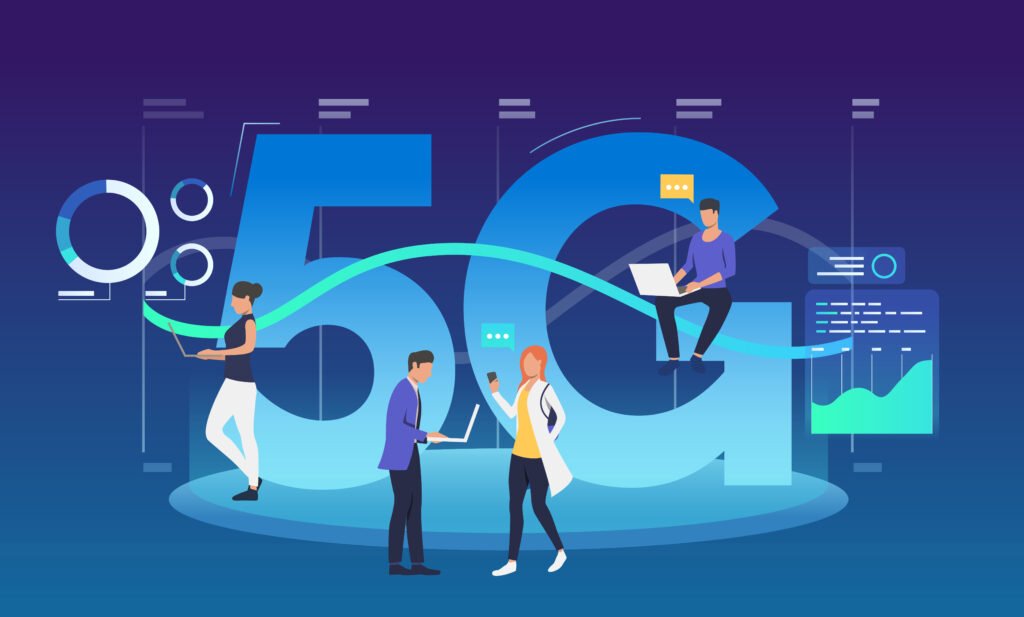Introduction to 5G Technology
In today’s rapidly evolving digital landscape, the advent of 5G technology stands as a monumental leap forward in wireless connectivity. 5G, the fifth generation of cellular networks, promises to revolutionize the way we communicate, interact, and innovate. This introduction serves to provide a comprehensive overview of 5G technology, encompassing its definition, evolution from previous generations, and key features.
A. Definition and Overview:
- 5G represents the latest iteration in cellular network technology, succeeding 4G LTE.
- It is designed to offer significantly faster data speeds, lower latency, and greater capacity compared to its predecessors.
- Beyond simply enhancing mobile broadband, 5G is envisioned as a transformative platform that will enable a wide array of applications across various industries and sectors.
B. Evolution from Previous Generations:
The journey towards 5G began with the introduction of 1G in the 1980s, followed by successive generations including 2G, 3G, and 4G.
Each generation has brought incremental improvements in terms of speed, capacity, and functionality, paving the way for the capabilities of 5G.
While 4G LTE laid the groundwork for mobile broadband and introduced features like video streaming and app downloads, 5G promises to take connectivity to unprecedented heights.
C. Key Features and Characteristics:
- Ultra-fast Speeds: 5G networks are expected to deliver peak data rates of up to 20 gigabits per second (Gbps), enabling seamless streaming of high-definition content, immersive gaming, and real-time communication.
- Low Latency: With latency reduced to as low as a few milliseconds, 5G will facilitate applications requiring instantaneous responsiveness, such as autonomous vehicles, remote surgery, and industrial automation.
- Massive Connectivity: 5G networks boast the capability to support a vast number of connected devices simultaneously, paving the way for the Internet of Things (IoT) to reach its full potential.
- Network Slicing: This feature allows operators to partition a single physical network into multiple virtual networks, each tailored to specific use cases or applications, thereby optimizing resource allocation and ensuring quality of service.
Technical Foundations of 5G
A. Spectrum Allocation and Utilization:
- Frequency Bands: Discuss the allocation of frequency bands for 5G deployment, including low, mid, and high bands.
- Spectrum Sharing: Explain the concept of dynamic spectrum sharing (DSS) and how it enables efficient spectrum utilization among different technologies.
- Spectrum Auctions: Highlight the role of governments and regulatory bodies in allocating spectrum through auctions to telecom operators.
B. Massive MIMO (Multiple Input Multiple Output) Technology:
- Definition and Principle: Define Massive MIMO and explain how it utilizes multiple antennas at both the transmitter and receiver to improve spectral efficiency and capacity.
- Beamforming Techniques: Describe beamforming techniques employed in Massive MIMO systems for directing radio signals toward specific users or areas, enhancing signal strength, and reducing interference.
- Spatial Multiplexing: Discuss how Massive MIMO enables spatial multiplexing, allowing multiple users to be served simultaneously on the same frequency channel.
C. Millimeter Wave Frequencies:
- Characteristics of Millimeter Waves: Explain the properties of millimeter waves, including their high frequency and short wavelength, and how they contribute to high data rates and capacity in 5G networks.
- Challenges and Solutions: Address challenges associated with millimeter wave propagation, such as susceptibility to attenuation and blockage, and discuss solutions like beamforming and small cell deployment.
- Use Cases: Explore potential use cases for millimeter wave technology, such as ultra-fast broadband in dense urban areas and high-capacity backhaul for network infrastructure.
D. Network Slicing and Virtualization:
- Concept of Network Slicing: Define network slicing as the partitioning of a single physical network into multiple virtual networks, each tailored to specific applications or services.
- Benefits: Discuss the benefits of network slicing, including improved resource allocation, enhanced service customization, and efficient support for diverse use cases.
- Implementation: Describe how network slicing is implemented in 5G networks using technologies like Software-Defined Networking (SDN) and Network Function Virtualization (NFV).
E. Beamforming and Beam Tracking:
- Beamforming in 5G: Explain how beamforming techniques are used in 5G to focus radio signals towards intended receivers, increasing signal strength and improving coverage and capacity.
- Adaptive Beamforming: Discuss adaptive beamforming algorithms that dynamically adjust beamforming parameters based on changing channel conditions, ensuring optimal performance in varying environments.
- Beam Tracking: Describe the process of beam tracking, where mobile devices and base stations continuously adjust beamforming parameters to maintain optimal signal quality as devices move within the network.
Benefits and Applications of 5G
5G technology promises a plethora of benefits and opens up a vast array of applications across various sectors. Here’s a closer look at some of the key advantages and potential applications:
A. Ultra-Fast Speeds and Low Latency:
With its significantly higher data transfer rates compared to previous generations, 5G enables ultra-fast download and upload speeds, revolutionizing the way we consume and share data.
Low latency, or the minimal delay between sending and receiving data, facilitates real-time communication and enhances user experience in applications such as online gaming, video streaming, and virtual meetings.
These capabilities not only improve personal entertainment but also drive innovation in industries like entertainment, gaming, and multimedia.
B. Enhanced Mobile Broadband (eMBB):
5G’s enhanced mobile broadband capabilities provide a seamless and high-quality internet experience on mobile devices, even in densely populated areas with heavy network traffic.
Streaming high-definition videos, downloading large files, and accessing cloud-based applications become faster and more reliable, catering to the increasing demands of mobile users.
C. Internet of Things (IoT) Connectivity:
5G’s massive device connectivity and support for a vast number of simultaneous connections make it ideal for powering the Internet of Things (IoT) ecosystem.
IoT devices, sensors, and smart appliances can communicate with each other and with central systems in real time, enabling efficient data collection, analysis, and automation across various industries such as manufacturing, agriculture, healthcare, and smart home technology.
Enhanced IoT connectivity facilitates the development of smart cities, where connected infrastructure improves energy efficiency, transportation systems, public safety, and overall urban living.
D. Augmented Reality (AR) and Virtual Reality (VR):
5G’s high bandwidth and low latency are instrumental in delivering immersive augmented reality (AR) and virtual reality (VR) experiences.
AR and VR applications benefit from seamless streaming of high-resolution content and real-time interaction, enabling immersive gaming, virtual tours, remote collaboration, and training simulations in fields like education, healthcare, and architecture.
E. Autonomous Vehicles and Smart Transportation:
5G plays a pivotal role in the development and deployment of autonomous vehicles and smart transportation systems.
Reliable and low-latency communication between vehicles, infrastructure, and central control systems enhances safety, traffic management, and efficiency on the roads.
Features such as real-time traffic updates, predictive maintenance, and vehicle-to-everything (V2X) communication enable the realization of fully autonomous and interconnected transportation networks.
F. Healthcare and Remote Surgery:
In the healthcare sector, 5G facilitates remote patient monitoring, telemedicine consultations, and remote surgery.
High-speed connectivity and low latency enable real-time transmission of medical data, high-resolution imaging, and remote control of surgical robots, allowing healthcare professionals to deliver timely and precise care, irrespective of geographical distances.
G. Smart Cities and Infrastructure:
5G forms the backbone of smart city initiatives, where interconnected devices, sensors, and infrastructure optimize resource utilization and improve the quality of life for residents.
Smart grids, intelligent transportation systems, environmental monitoring, and public safety applications benefit from 5G’s fast and reliable connectivity, paving the way for sustainable urban development and efficient resource management.
Overall, the benefits and applications of 5G technology extend far beyond just faster mobile internet, encompassing transformative innovations across industries and revolutionizing the way we live, work, and interact with the world around us.
Challenges and Limitations
Despite its promise, the deployment and widespread adoption of 5G technology come with several challenges and limitations that need to be addressed:
A. Infrastructure Requirements:
- Cost: Building out the infrastructure necessary for 5G networks, including the installation of small cells and upgrading existing infrastructure, requires significant financial investment.
- Time: Deploying 5G infrastructure is a time-consuming process, involving permits, regulatory approvals, and physical installation, which can lead to delays in rollout.
B. Spectrum Availability and Regulation:
- Spectrum Allocation: The availability of suitable spectrum bands for 5G varies across different regions, leading to potential spectrum scarcity and competition among operators.
- Regulatory Hurdles: Spectrum allocation and regulatory policies differ from country to country, leading to inconsistencies and challenges in harmonizing spectrum use globally.
C. Security and Privacy Concerns:
- Cybersecurity Risks: With the increased connectivity and complexity of 5G networks, there is a higher risk of cyberattacks targeting critical infrastructure, sensitive data, and connected devices.
- Privacy Issues: The proliferation of data generated by 5G-connected devices raises concerns about privacy breaches and unauthorized access to personal information.
D. Potential Health Risks:
- Electromagnetic Radiation: Some studies suggest that exposure to electromagnetic radiation from 5G infrastructure and devices may have adverse health effects, although scientific consensus on this issue is still evolving.
- Public Perception: Despite limited scientific evidence, concerns about the potential health risks of 5G technology have led to public skepticism and opposition in some communities.
E. Digital Divide and Accessibility Issues:
- Unequal Access: The rollout of 5G networks may exacerbate existing disparities in internet access, particularly in rural and underserved areas where infrastructure deployment is less economically viable.
- Affordability: The high cost of 5G-compatible devices and data plans may exclude low-income individuals and communities from accessing the benefits of ultra-fast wireless connectivity.
Deployment and Adoption of 5G
5G deployment and adoption have been significant milestones in the telecommunications industry, with various countries and telecom operators racing to roll out this next-generation technology. Here’s a closer look at the current state of deployment and the factors influencing its adoption:
Global Rollout:
- Countries around the world have been actively deploying 5G networks, with varying degrees of progress.
- Leading countries in 5G deployment include the United States, China, South Korea, Japan, and certain European nations.
- Telecom operators have been investing heavily in infrastructure upgrades to support 5G deployment, including the installation of new base stations and upgrading existing ones.
Market Trends:
- The demand for 5G services has been steadily increasing, driven by the growing need for ultra-fast connectivity and low latency.
- Industries such as manufacturing, healthcare, automotive, and entertainment are embracing 5G technology to enable innovative applications and services.
- The proliferation of Internet of Things (IoT) devices and smart technologies is further driving the adoption of 5G networks.
Industry Adoption and Use Cases:
- Various industries are leveraging 5G technology to enhance their operations and deliver new services.
- For example, in the healthcare sector, 5G enables remote patient monitoring, telemedicine, and real-time data transmission for critical procedures.
- In manufacturing, 5G-powered Industrial Internet of Things (IIoT) applications improve automation, asset tracking, and predictive maintenance.
- Media and entertainment companies are exploring 5G for delivering high-definition content, immersive experiences, and augmented reality applications.
Consumer Adoption and Impact on Daily Life:
Consumers are experiencing the benefits of 5G through faster download speeds, smoother streaming, and improved gaming experiences.
Smartphones and other consumer devices with 5G capabilities are becoming increasingly popular, driving consumer adoption.
Enhanced connectivity and seamless communication offered by 5G are transforming the way people interact, work, and consume content.
Challenges in Developing Countries:
While developed nations are making rapid progress in 5G deployment, many developing countries face challenges in infrastructure, funding, and regulatory frameworks.
Bridging the digital divide and ensuring equitable access to 5G technology remain significant challenges for policymakers and stakeholders in developing regions.
International collaboration and partnerships are essential for supporting 5G deployment in underserved areas and driving global connectivity.
Conclusion
In conclusion, 5G technology stands poised to revolutionize the way we connect, communicate, and interact with the world around us. With its unprecedented speeds, ultra-low latency, and massive connectivity capabilities, 5G promises to unlock a wave of innovation across industries and transform everyday experiences for billions of people worldwide.
From enabling seamless virtual reality experiences to powering autonomous vehicles and smart cities, the potential applications of 5G are limitless. However, as with any transformative technology, challenges such as infrastructure requirements, spectrum regulation, and security concerns must be carefully addressed to ensure widespread adoption and equitable access.
Despite these challenges, the momentum behind 5G deployment continues to grow, with governments, industries, and consumers alike recognizing the immense opportunities it presents. As we embark on this new era of connectivity, it is essential to remain vigilant in addressing the societal, economic, and ethical implications of 5G technology, ensuring that its benefits are shared by all.
Looking ahead, the future of 5G holds even greater promise, with emerging technologies such as 6G and advancements in AI and edge computing poised to further enhance its capabilities. By embracing innovation, collaboration, and responsible stewardship, we can harness the full potential of 5G technology to create a more connected, efficient, and sustainable future for generations to come.
In this fast-paced digital age, the power of ultra-fast wireless connectivity offered by 5G is truly unleashing a new era of possibility. As we stand on the brink of this technological revolution, let us seize the opportunities it presents and work together to build a brighter, more connected future for all.












